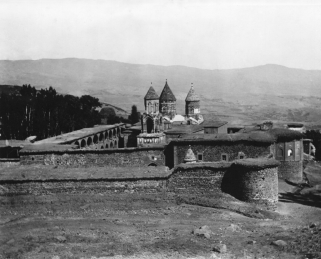Surb Karapet Monastery
| Surb Karapet Monastery | |
|---|---|
|
The monastery before its destruction in 1915[1] | |
 Shown within Turkey | |
| Basic information | |
| Location | Çengilli köyü,[2][3] Muş Province, Turkey |
| Geographic coordinates | 38°57′40″N 41°11′30″E / 38.961068°N 41.191697°ECoordinates: 38°57′40″N 41°11′30″E / 38.961068°N 41.191697°E |
| Affiliation | Armenian Apostolic Church |
| Status | Completely demolished;[4][5] some traces remain[6][7] |
| Architectural description | |
| Architectural type | Monastery |
| Architectural style | Armenian |
| Founder | Gregory the Illuminator |
| Groundbreaking | 4th century (traditional date) |
| Completed | 4th–19th centuries[8] |
Surb Karapet Monastery (Armenian: Մշո Սուրբ Կարապետ վանք, Mšo Surb Karapet vank',[upper-alpha 1] also known by other names) was an Armenian monastery in the historic province of Taron, about 30 km (19 mi) northwest of Mush (Muş), in present-day eastern Turkey.
Surb Karapet translates to "Holy Precursor" and refers to John the Baptist, whose remains are believed to have been stored at the site by Gregory the Illuminator in the early fourth century. The monastery subsequently served as a stronghold of the Mamikonians—the princely house of Taron, who claimed to be the holy warriors of John the Baptist, their patron saint. It was expanded and renovated many times in later centuries. By the 20th century it was a large fort-like enclosure with four chapels.
Historically, the monastery was the religious center of Taron and was a prominent pilgrimage site. It was considered the most important monastery in Turkish (Western) Armenia and the second most important of all Armenian monasteries after Etchmiadzin. From the 12th century the monastery was the seat of the diocese of Taron, which had an Armenian population of 90,000 in the early 20th century. It attracted pilgrims on several occasions annually and host large celebrations. The monastery was burned and robbed during the Armenian Genocide of 1915 and later abandoned. Its stones have since been used by the local Kurds for building purposes.
Names
Throughout history the monastery has been known by several names. One of the common names was Glakavank (Գլակավանք), meaning "Monastery of Glak" after its first father superior, Zenob Glak.[9] It is also spelled Glaka vank (classical spelling: Գլակայ վանք; reformed spelling: Գլակա վանք) or Klaga vank (from Western Armenian).[10] Due to its location it was also called Innaknian vank[11] (Իննակնեան վանք in classical spelling,[12] and Իննակնյան վանք in reformed), translating to "Monastery of the Nine Springs".[11]
Turkish sources refer to it as Çanlı Kilise[13] (Turkish: "Church with Bell Towers"),[14] or Çengelli Kilise[15] (meaning "Church with Bells" in Kurdish,[16] also the name of the village in which it is located). They sometimes provide a version of its Armenian name: Surpgarabet Manastırı.[3][13] Turkish sources and travel guides generally omit the fact that it was an Armenian monastery.[14]
History
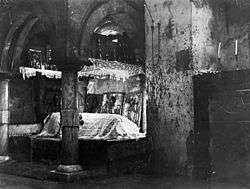
Foundation to the Middle Ages
According to tradition, the site was founded in the early fourth century by Gregory the Illuminator, who went to Taron to spread Christianity, following the conversion of King Tiridates III of Armenia. At the time, there were two Hindu temples and brass statues established by two Indian princes dedicated to the gods Gisané and Demeter on the site of the cloister.[17][11] They were razed to the ground by Gregory the Illuminator, who erected a martyrion[18][upper-alpha 2] to house the remains of Saints Athenogenes and John the Baptist[20][21] which he had brought from Caesarea.[22][17] According to other sources the pagan temples were dedicated to Vahagn and Astghik. James R. Russell suggests that in Armenia some of the qualities of the pagan god Vahagn were passed down to John the Baptist. Folk belief held that devs (demons) were kept underneath the monastery; they would be released during the Second Coming by John the Baptist (Surb Karapet).[23] Christina Maranci suggested that the foundation of the monastery is "most probably connected with the rise of the monastic movement" in Bagratuni Armenia in the 940s.[24]
Zenob Glak, a Syriac archbishop, became its first father superior. He is sometimes mentioned as the author of History of Taron (Patmutiun Tarono, Պատմութիւն Տարօնոյ),[11] although the work is generally attributed to the otherwise unknown John Mamikonean and "scholars are convinced that the work is an original composition of a later period (post-eighth century), written as a deliberate forgery."[25] Its main purpose seems to be asserting the monastery's preeminence.[11] A relatively short "historical" romance,[25] it tells the story of the five members of the Mamikonians, Taron's princely house: Mushegh, Vahan, Smbat, his son Vahan Kamsarakan, and the latter's son Tiran, who were known as the Holy Warriors of John the Baptist, their patron saint.[25] They defended the monastery and other churches in the district.[11]
The sixth century chronicler Atanas Taronatsi (Athanas of Taron) served as its father superior. He is best remembered for collocation of the Armenian calendar.[26] The monastery's possessions were expanded in the seventh century, but the building was reduced to ruins by an earthquake in the same century. It was subsequently rebuilt and the chapel of Surb Stepanos (St. Stephen) was founded.[20]
In the late ninth century, following the establishment of Bagratid Armenia, a school was founded at the monastery.[27] In the 11th century Grigor Magistros built a palace within the monastery, but it was destroyed by fire in 1058 along with St. Gregory (Grigor) Church which had a wooden roof.[20] Following the death of the Sökmen II Shah Armen in 1185 the monastery was attacked by Muslims. Archbishop Stepanos was killed and the monks abandoned the monastery for a year.[28]
Modern period
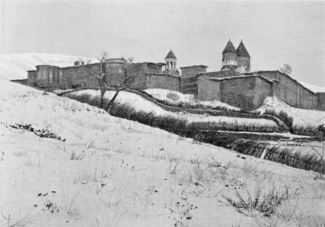
In the mid-16th century the Surb Karapet chapel was built.[20] According to the 17th-century traveler Evliya Çelebi the leadership of the monastery made large gifts to Turkish pashas in order to secure the monastic properties.[30] From the 16th to the 18th centuries the monastery often sheltered Armenians fleeing the Ottoman–Persian Wars. In the 1750s, the Surb Karapet church was destroyed by Persian troops. In the 18th century, several earthquakes hit the monastery. The one in 1784 being especially devastating; destroyed the main church, the refectory, part of the bell tower and the southern wall. In 1788 the monastic complex underwent complete reconstruction—its gavit (a square or quadrangular chamber placed in front of the church and on the same axis, destined for both civil and religious use) was enlarged, and renovation was carried out in its belfry, the monks' cells, scriptorium, ramparts and other sections.[16]
19th century
In 1827 Kurdish gangs seized and robbed the monastery, destroying the furniture and manuscripts.[20] However, the monastery prospered at the beginning in 1862 when Mkrtich Khrimian became its father superior and, simultaneously, prelate of Taron.[31] Khrimian sought to reform the way donations were handled by establishing a council which would finance community projects. Before him, most of the money went to the monks and affluent Armenians of the region who offered fierce opposition to him, including two attempts on his life.[32] In his first year he founded a largely secular school at the monastery, called Zharangavorats.[33][34] Among others, the fedayi Kevork Chavush[35] and Hrayr Dzhoghk,[36] the singer Armenak Shahmuradyan,[37] and the writer Gegham Ter-Karapetian (Msho Gegham)[38] studied there. From April 1, 1863 until June 1, 1865 Khrimian published the journal The Eaglet of Taron[39] (Artzvik Tarono, «Արծւիկ Տարօնոյ») at the monastery. It was written in modern Armenian, rendered to be easily readable for the ordinary people. The journal sought to raise the national consciousness of the Armenians.[33] Edited by Garegin Srvandztiants, a total of 43 issues were published.[40] Khrimian left the monastery in 1868 when he became the Armenian Patriarch of Constantinople.[34]
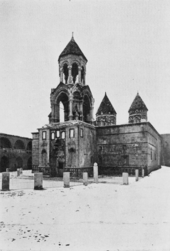
_b.jpg)
The monastery, according to two French travelers in 1890, possessed large areas of land and it took several hours to get from one end to another. The estate was covered by forests, arable fields and had three farms with around a thousand goats and sheep, a hundred oxen and cattle, sixty horses, twenty donkeys and four mules, which were taken care of by 156 servants.[41] In 1896 an orphanage was founded next to the monastery. It housed a school for 45 children and a library.[20]
According to British traveler H. F. B. Lynch, who visited the monastery in 1893, with the presence of the Kurdish threat and the suspicions of the Turkish government "this once flourishing monastery has been stripped of much of its glamour; indeed the monks are little better than prisoners of State."[42] The monastery was robbed in 1895 during the Hamidian massacres.[43] By the early 20th century the monastery's structure was deteriorating.[44] The decline continued until the start of World War I.[6]
Destruction and current state
During the Armenian Genocide of 1915 the monastery housed a large number of Armenians escaping the deportations and massacres. Turkish forces and Kurdish irregulars sieged it, but the Armenians within resisted for more than two months.[16] According to contemporary reports, around five thousand Armenians were massacred "near the wall of the monastery", while the monastery itself was "sacked and robbed".[45] According to the American missionaries Clarence Ussher and Grace Knapp, the Turks slaughtered "three thousand men, women, and children" gathered at the courtyard of the monastery on command of a German officer.[46]
In 1916 the Russian troops and Armenian volunteers temporarily took control of the area and transferred around 1,750 manuscripts to Etchmiadzin.[20][5] Among them is an 18th-century reliquary of the right hand of John the Baptist made of silver repoussé.[5] The area was recaptured by the Turks in 1918 and, subsequently, ceased to exist not only as a spiritual center, but also as an architectural monument. It remained abandoned until the 1960s when Kurdish families settled on the site.[6]
Many buildings in the village include stones from the monastery and khachkars (cross stones), which are embedded in the walls.[upper-alpha 3] The remaining stones are "being systematically carried off by the local Kurds for their own building purposes."[51] According to historian Robert H. Hewsen, as of 2001, only traces of two chambers of the chapel of Surb Stepanos remain, while the rest of the monastery's remains consist of "foundations and ruined walls",[6] which are used as barns.[52]
- Reconstruction efforts
In May 2015 Aziz Dagcı, the President of the NGO "Union of Social Solidarity and Culture for Bitlis, Batman, Van, Mush and Sasun Armenians", made a formal appeal to the Turkish Ministries of Culture and Interior requesting the reconstruction of the monastery and the removal of all 48 houses and 6 barns on its former location. Dagcı stated that according to the 1923 Treaty of Lausanne the Turkish government obliged to preserve the religious institutions and structures of ethno-religious minorities, including those of the Armenian community. He added that he first forwarded a letter to government agencies in 2012 who promised to clean the site within six months.[53][54]
Architecture
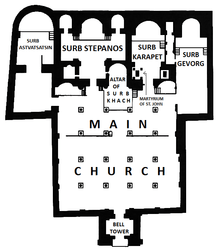
The monastery was surrounded by strong walls[5] and was similar to a fortress. Historian Dickran Kouymjian called it "a vast walled hermitage".[55] Lynch, who visited it in 1893, described the monastery as follows: "A walled enclosure, like that of a fortress, a massive door on grating hinges—such is your first impression of this lonely fane. [...] You enter a spacious court, and face a handsome belfry and porch, the façade inlaid with slabs of white marble with bas-reliefs."[56] A decade earlier, English traveler Henry Fanshawe Tozer wrote of the monastery: "The buildings ... are of stone, very massive and very irregular, rising one above another at various angles. There was hardly any pretence of architecture, and none of the picturesque appearance which is so characteristic of Greek monasteries."[57]
Structure
The monastery complex was composed of the main church, dedicated to the Holy Cross (Surb Khach) and four chapels to the east: Surb Astvatsatsin (Holy Mother of God), Surb Stepanos (Saint Stephen), Surb Karapet (Holy Precursor) and Surb Gevorg (Saint George). The main church was not a typical Armenian church but was a large hall and is believed to have originally functioned as a zhamatun (chamber).[5] It was built of mostly gray stones[9] and was supported by 16 columns.[5] The chapels of Surb Karapet and Surb Stepanos had domes, with "high cylindrical drums and conical roofs".[58] The chapel of Surb Astvatsatsin was provided to Syriac (Assyrian) monks on the feast of St. John.[59]
The three-storey bell tower was built in the 18th century.[5] There were also monk cells, a refectory, accommodations for pilgrims, the 19th-century prelacy building and a monastic school.[60]
Cultural significance
The monastery was historically the religious center of Taron.[61][62] From the 12th century[61] the monastery was the seat of the diocese of Taron, which had an Armenian population of 90,000 (circa 1911).[63] It considered the largest and most eminent shrine in Western (Turkish) Armenia.[upper-alpha 4] It was the second most important Armenian monastery after Etchmiadzin.[upper-alpha 5] It remained a prominent pilgrimage site until the First World War.[6] People from every corner of Armenia made pilgrimages to the monastery. They usually held festivities at the monastery's yard.[16] It was considered by believers to be "almighty"[20] and was renowned for its perceived ability to heal the physically[20] and mentally ill.[67]
The monastery was popularly known as Մշո սուլթան Սուրբ Կարապետ Msho sultan Surb Karapet, literally translating to "Sultan Surb Karapet of Mush". The epithet "Sultan" was bestowed as a reference to its high status as the "lord and master" of Taron.[68]
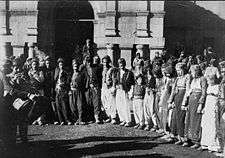
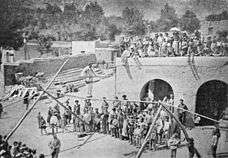
The monastery housed tombs of several Mamikonian princes, "for whom the shrine served as a sepulchral abbey."[6] According to Lynch, the tombs of Mushegh, Vahan the Wolf, Smbat and Vahan Kamsarakan could have been found near the southern wall of the monastery.[42]
Annual events
The monastery was a center of large annual celebrations. Various secular events took place in the surroundings, such as horse races, tightrope walking and Gusan competitions during the festivals of Vardavar[69][70][71] and Assumption of Mary.[20] Horse racing competitions were held on Vardavar and involved a large number of people.[72] Tightrope walking, widely practiced by the Armenians of Taron, was historically related to the worship of the monastery.[73]
Ashugh tradition
The monastery was a traditional pilgrimage site for Armenian ashughs (folk musicians).[74][75] It has been compared to Mount Parnassus in Greece, which was the home of the Muses.[76][77] The prominent 18th-century ashugh Sayat-Nova is recorded to have made a trip to the monastery to seek divine grace.[75][78]
Cultural references
Numerous songs were dedicated to the monastery.[79]
In the 1866 novel Salbi (Սալբի) Raffi mentions the monastery and describes its perceived almightiness.[80]
Hovhannes Tumanyan describes the monastery in the 1890 poem "The morning of Taron" (Տարոնի առավոտը) as "magnificently ornamented".[81]
In the seven-thousand-line long poem "Ever-Tolling Bell Tower" («Անլռելի զանգակատուն») Paruyr Sevak mentions the monastery and its well-known bells.[82] The poem, published in 1959, is dedicated to Komitas, who was among those intellectuals who were deported on April 24, 1915 during the genocide. It is recognized as "one of the most powerful literary responses to the Armenian Genocide."[83]
In the historical novel The Call of Plowmen («Ռանչպարների կանչը», published in 1979), Khachik Dashtents describes a winter scene at the monastery.[84]
In October 2010 during the discussion of a bill in the Armenian Parliament that would formally recognize the Nagorno-Karabakh Republic, opposition MP Raffi Hovannisian ended his speech saying "Let us be guided by Msho Sultan Surb Karapet"[85] (Մշո սուլթան Սուրբ Կարապետ մեզի լինի օգնական).[86]
Silver cross
In August 2013 an Armenian-style silver cross attributed by the seller to the Surb Karapet Monastery appeared on the Russian auction website Bay.ru and was valued at $70,000.[87] The Mother See of Holy Etchmiadzin said that they were trying "to verify the details regarding the news reports about the auction."[88] Art historian Levon Chookaszian noted the seller did not provide much information. He added that "All we can see is that it is delicate silver work and nothing else is known [about it]."[89]
See also
- Arakelots Monastery, another prominent monastery in Taron
- Armenian cultural heritage in Turkey
References
Notes
- ↑ Classical Armenian orthography: Մշոյ Սուրբ Կարապետ վանք; Western Armenian pronunciation: Mšo Surp Garabed vank'
- ↑ According to Jean-Michel Thierry, the martyrium of John the Baptist was probably at first a hall-shaped building with archaic-style cupola, but was later much altered.[19]
- ↑ "Their homes, built from the fine dressed stones of the monastery, are often found decorated with khachkars taken from the ruins."[6]
"Today Saint Karapet consists of a few shapeless ruins, carved stones and khachkars which have been used as building material by the current Muslim residents (mostly Zaza Kurds), and are often found embedded in the walls of local homes and structures."[47]
"Moreover, lots of houses carried a mark of the past, both in terms of memory and actual stones. Khackhars and stone blocks from the monastery had been dispersed and used as building material in the new village. We could see these stones among newer ones in the foundations and walls of homes in Chengilli."[48]
"Մշո Սուրբ Կարապետ եկեղեցուց պոկած քարերով տներ են կառուցել"[49]
"Մշո Սուրբ Կարապետն ամբողջովին ավերված էր, որի տարածքում գտնվող քրդերի տները կառուցված էին վանքի սրբատաշ քարերից և խաչքարերից"[50] - ↑ "Ս. Կարապետի վանքը Արևմտյան Հայաստանում համարվում էր ամենամեծ ու ամենանվիրական սրբավայրը։ Նա ոչ միայն Տարոն աշխարհի ամենանշանավոր վանքն էր, այլև ամբողջ հայությանը ծանոթ մեծագույն մենաստանը ս. Էջմիածնից հետո։ Նրա համբավն ու հռչակը դուրս էր եկել ազգային սահմաններից և դարձել նաև սրբավայր տեղացի և օտար ազգերի համար: Բացի այդ, մեր մատենագիրների մոտ կան հիշատակություններ, որ օտարազգի քրիստոնյաներ շատ հաճախ են ուխտի եկել ս. Կարապետի վանքը։"[64]
"Արեւմտեան Հայաստանի մեծագոյն սրբատեղին եւ ուխտավայրն էր Ս. Կարապետը..."[65] - ↑ "Հայաստանի հոգևոր կենտրոնների մեջ իր դերով ու նշանակությամբ եղել է երկրորդը (Էջմիածնից հետո):"[20]
"Until the 1915 genocide the monastery dedicated to Surb Karapet in the environment of Mush, west of Lake Van in present-day Turkey, was a pilgrimage site surpassed in importance only by Etchmiadzin, the See of the Armenian Apostolic Church, and perhaps Jerusalem."[66]
References
- ↑ "Armenian monastery of Surb Karapet (the Holy Precursor, St. John the Baptist) in Mush (Muş İli), Turkey". Library of Congress.
- ↑ Mildanoğlu, Zakarya (1 November 2013). "Manastır taşlarıyla örmüşler Muş'u dört baştan". Agos (in Turkish).
Bugün bu görkemli manastırdan sadece bir iki duvar kalmış. Eşsiz zenginlikteki taş işçiliği örnekleri ise Çengilli köyü camisi dahil pek çok binanın duvarlarında yer alıyor.
- 1 2 "Kilise ve Manastır [Church and monastery]" (in Turkish). Muş Province Culture and Tourism Directorate. Archived from the original on 23 September 2014.
- ↑ Adalian, Rouben Paul (2010). Historical Dictionary of Armenia. Lanham, Maryland: Scarecrow Press. p. 94. ISBN 978-0-8108-7450-3.
The oldest pilgrimage site in Armenia, the monastery of Surb Karapet, St. John the Baptist, in Moush, the starting locus of Armenian Christianity, where a large cathedral stood, is entirely gone.
- 1 2 3 4 5 6 7 Maranci 2002, p. 123.
- 1 2 3 4 5 6 7 8 Hewsen, Robert H. (2001). "Mush and Its Plain". Armenia: A Historical Atlas. Chicago: University of Chicago Press. p. 206. ISBN 0-226-33228-4.
- ↑ Archdeacon Charles Hardy (May 2000). "In Search of Our Roots – An Armenian Odyssey". bvahan.com.
The vank is completely in ruins. Remaining are a few stone structures facing each other about thirty feet apart.
- ↑ "St. Karapet Monastery, 4th–19th centuries". Research on Armenian Architecture. Archived from the original on 23 September 2014.
At present the Kurdish village of Changli is situated in the site of the monastery. The ruined parts of the monastery laid in the walls of different buildings in the present-day village.
- 1 2 Avetisyan 1979, p. 203.
- ↑ Saint-Martin, Jean (1818). Mémoires historiques et géographiques sur l'Arménie (in French). Paris: Imprimerie Royale. p. 101.
- 1 2 3 4 5 6 Hacikyan, Agop Jack; Basmajian, Gabriel; Franchuk, Edward S.; Ouzounian, Nourhan (2002). "Zenob Glak". The Heritage of Armenian Literature: From the sixth to the eighteenth century. Detroit: Wayne State University Press. pp. 100–101. ISBN 9780814330234.
- ↑ ՜՜Սուրբ Կարապետ՝՝ Քրիստոնեայ Հայոց Առաջին Աղօթավայրը (in Armenian). Vatican Radio. 18 January 2011.
...վանքը առած է նաեւ Իննակնեան վանք անունը։
- 1 2 "Tarihi Eserler [Historical monuments]" (in Turkish). Muş Valiliği. Archived from the original on 23 September 2014.
Çanlı Kilise (Surpgarabet Manastırı)
- 1 2 Hovhannisyan, A. "Armenian Mush: Yesterday and Today" (PDF). Institute of Oriental Studies of the Armenian National Academy of Sciences. Archived from the original (PDF) on 23 September 2014.
Մշո Առաքելոց և Սբ. Կարապետ վանքերը միակ հնություններն են, որոնք հիշատակվում ենզբոսաշրջիկների ուղեցույցներում, այն էլ թրքացված ձևով (Arak venki և Çanlı kilise, այսինքն` զանգակատնով եկեղեցի), առանց նշելու նրանց հայկական ծագումը: Նույն ուղեցույցների Մուշի պատմությանը նվիրված ակնարկներում հայերի մասին հիշատակում չկա:
- ↑ Hayat türkiye ansiklopedisi (in Turkish). Istanbul: Tifdruk. 1965. p. 415. OCLC 4848797.
...Surb-Karabet Manastırı (ki Türkler «Canlı» veya «Çengelli Kilise» derlerdi)...
- 1 2 3 4 "Issue dedicated to the memory of architecture historian Armen Hakhnazarian" (PDF). Vardzk (Research on Armenian Architecture) (1): 29–30. January–June 2010.
- 1 2 Ghrejyan 2010, p. 187.
- ↑ Terian, Abraham. "An Overview of Early Armenian Monasticism". bc.edu. St. Nersess Armenian Seminary.
The famous church and monastery of Surb Karapet, near Mush, traced its history to the martyrion built by St. Gregory over the relics of St. John the Baptist. In time, a cluster of chapels grew within the compound, with numerous graves of past bishops in them. Like other important sites in Tarôn, the place was a site for year-round pilgrimage, but especially on the feast-day of the Forerunner, John the Baptist, Surb Karapet. The nine springs that surrounded the site added to its monastic attraction.
- ↑ Thierry, Jean-Michel (1989). Armenian Art. New York: Harry N. Abrams, Inc. p. 175. ISBN 978-0810906259.
- 1 2 3 4 5 6 7 8 9 10 11 Vardanian, V.; Zarian, A. (1981). "Մշո Ս. Կարապետ վանք [S. Karapet monastery of Mush]". Soviet Armenian Encyclopedia Volume 7 (in Armenian). Yerevan: Armenian Encyclopedia. p. 660.
- ↑ Avetisyan 1979, p. 204.
- ↑ Ս. Աթանագինե եպիսկոպոսի և նրա տաս աշակերտների նահատակության հիշատակության օր. araratian-tem.am (in Armenian). Araratian Pontifical Diocese. Archived from the original on 21 December 2014.
Ս. Գրիգոր Լուսավորիչը, ով մինչ Տրդատ արքայի մոտ ծառայության անցնելն ամուսնացած էր Աթանագինեի քրոջ՝ Մարիամի հետ, Կեսարիայից վերադառնալիս նրա մասունքները Ս. Հովհաննես Մկրտչի նշխարների հետ Հայաստան է բերում և թաղում Տարոն գավառի Գլակա վանքում:
- ↑ van Lint 2005, p. 352.
- ↑ Maranci 2002, p. 122.
- 1 2 3 Mamikonean 1985, Translator's Preface
- ↑ Matevossian, Artashes (1989). "Մովսես Խորենացին և Աթանաս Տարոնացու ժամանակագրությունը [Movses Khorenatsi and Atanas Taronatsi's Chronicle]". Patma-Banasirakan Handes (in Armenian) (1): 225.
Տարոնի Ս. Կարապետ վանքի առաջնորդ Աթանաս Տարոնացին է, որը կարգել է հայոց նոր թվականությունը, այն սկսելով 552 թ.
- ↑ Mkhitarian, S. M. (2005). "Մաշտոցյան ավանդույթները հայ դպրոցում (Հայ գրերի գյուտի, դպրոցի և դպրության 1600-ամյակի առթիվ) [The Mashtots Traditions in Armenian Schools (to the 1600th Anniversary of the Creation of Armenian Written Language and School)]". Lraber Hasarakakan Gitutyunneri (in Armenian): 105.
885 թ. պետականության վերականգնումից հետո կյանքն աստիճանաբար վերափոխվում է, և դպրոցի այս տիպը (վանական) մեծ զարգացում ու տարածում է գտնում: Այսպիսի դպրոցներ են բացվում [...] Մշո Գլակա ու Առաքելոց վանքերում, Նարեկա վանքում և այլուր:
- ↑ Matevosyan, Karen (2007). "Մշո Սբ. Կարապետ վանքի պատմության մի դրվագ [A Historical Fragment of St. Karapet Church in Mush]". Patma-Banasirakan Handes (in Armenian) (1): 197.
- ↑ Lynch 1901, pp. 176–177.
- ↑ Papazian, A. H. (1992). "Թուրքական աղբյուրները Հայաստանի և հայերի մասին (XVI—XVIII դդ.) (Համառոտ ակնարկ) [The Turkish Sources about Armenia and Armenians (XVI-XVIII centuries)]". Patma-Banasirakan Handes (in Armenian) (1): 104.
Առավել ուշադրության արժանի են Մշո Ս. Կարապետ վանքին վերաբերող նյութերը։ Այստեղ ցույց է տրված, թե վանական կալվածների գոյությունը վտանգից զերծ պահելու համար, վանքի հոգևոր առաջնորդները ինչպիսի մեծ նվիրատվություններ են կատարել թուրք փաշաներին:
- ↑ Costandian 1999, p. 66.
- ↑ Derderian, Dzovinar (16 December 2014). "Mapping the Fatherland: Artzvi Vaspurakan's Reforms through the Memory of the Past". houshamadyan.org.
- 1 2 Costandian 1999, p. 67.
- 1 2 "Խրիմյան Հայրիկ [Khrimian Hayrik]" (in Armenian). Institute for Armenian Studies of Yerevan State University.
- ↑ "Գևորգ Չավուշ [Gevorg Chavush]". encyclopedia.am (in Armenian). Armenian Encyclopedia.
Գևորգ Չավուշը (իսկական ազգանունը՝ Ղազարյան) 1886–88 թթ-ին սովորել է Մշո Սբ Կարապետ վանքի դպրոցում, որը նրա ուսուցիչ Հովհաննես վարդապետ Մուրադյանի ջանքերով վերածվել էր ազատագրական գաղափարների տարածման կենտրոնի:
- ↑ Harutyunyan, G. (1980). "Հրայր [Hrayr]". Soviet Armenian Encyclopedia Volume 6 (in Armenian). p. 620.
Սովորել է Տարոնի Ղզլաղաճ գյուղի, Մշո Ս. Կարապետ վանքի և Միացյալ ընկերության դպրոցներում:
- ↑ "Շահմուրադյան Արմենակ [Armenak Shahmuradyan]". encyclopedia.am (in Armenian). Armenian Encyclopedia.
Հետագայում ուսումը շարունակել է Մշո Սբ Կարապետ վանքի ժառանգավորաց դպրոցում...
- ↑ Kaligian, Dikran Mesrob (2009). Armenian Organization and Ideology Under Ottoman Rule: 1908–1914. Transaction Publishers. p. 38. ISBN 978-1-4128-4245-7.
He was educated at St. Garabed Monastery in Muş...
- ↑ Hacikyan, Agop Jack; Basmajian, Gabriel; Franchuk, Edward S.; Ouzounian, Nourhan (2005). The Heritage of Armenian Literature: From the eighteenth century to modern times. Detroit: Wayne State University Press. p. 372. ISBN 9780814332214.
- ↑ Avetisyan 1979, p. 206.
- ↑ Hambaryan, Azat (2000). "Արևմտահայ վանական տնտեսությունը (XIX դարի երկրորդ կես – XX դարի սկիզբ) [Monasterial Economy in Western Armenia (second half of XIX century beginning of XX century)]". Patma-Banasirakan Handes (in Armenian) (2): 34.
- 1 2 Lynch 1901, p. 179.
- ↑ Avagyan, Gohar (2014). "Փաստաթղթեր 1894–1896 թթ. հայկական կոտորածների վերաբերյալ (Բիթլիսի նահանգ) [Documents on Armenian Massacres in 1894–1896 (Bitlis Province))]" (PDF). Armenological Issues (in Armenian) (Yerevan State University) (1): 119–142.
Ս. Կարապետի վանքն ևս կողոպտուած է:
- ↑ "Մշոյ Ս. Կարապետ վանքի ողբալի վիճակը [The tragic condition of the Surb Karapet monastery of Mush]". Luma (in Armenian) (Tiflis) (5): 248–249. 1903.
- ↑ Toynbee, Arnold, ed. (1916). "Moush: Resume of Information Furnished by Refugees in the Caucasus and Published in the Caucasian Press, Especially in the Armenian Journal "Mschak"; complied by Mr. G. h. Paelian, and Communicated by him to the Armenian Journal "Ararat," of London, March, 1916.". The Treatment of Armenians in the Ottoman Empire, 1915–1916: Documents Presented to Viscount Grey of Fallodon by Viscount Bryce, with a Preface by Viscount Bryce. London: Hodder & Stoughton. pp. 94–95.
- ↑ Ussher, Clarence; Knapp, Grace (1917). An American Physician in Turkey: A Narrative of Adventures in Peace and War. Houghton Mifflin. pp. 207–8.
At Surp Garabed Monastery, near Mush, a German officer was in command of the artillery which overcame the Armenians who were defending their women and children. When they were disarmed and huddled into the courtyard of the monastery, this officer mounted the wall and harangued them, upbraiding them for their lack of loyalty to Turkey and her allies; then, by firing a pistol, gave the signal to the Turks to slaughter three thousand men, women, and children gathered there.
- ↑ Kharatyan et al. 2013, p. 107.
- ↑ Kharatyan et al. 2013, p. 69.
- ↑ Վարագան՝ քրդերի ձեռքին. Aravot (in Armenian). 23 November 2006.
- ↑ Gharabaghtsyan, Sergo (January–February 2006). Ուխտագնացություն դեպի էրգիր. Charagayt (in Armenian). Archived from the original on 21 December 2014.
- ↑ Darke, Diana (2011). Eastern Turkey. Bradt Travel Guides. p. 131. ISBN 9781841623399.
- ↑ Örer, Ayça (30 July 2013). "Muş'taki Ermeni mirasının yıkımı durdu". Radikal (in Turkish).
Muş'taki Surp Garabet Manastırı'na gittik, geriye biraz duvar ve tonozlar kalmış, altına ahır yapılmış.
- ↑ "Surp Garabet Manastırı için harekete geçildi". Milliyet (in Turkish). 29 May 2015.
- ↑ Մշոյ Սուրբ Կարապետ Վանքի Վերականգնման Համար Դիմում Ներկայացուած Է Կառավարութեան. Aztag (in Armenian). 9 June 2015.
- ↑ Kouymjian, Dickran (September–October 2014). "An Armenian Liturgical Curtain" (PDF). The Cleveland Museum of Art Members Magazine (Cleveland Museum of Art): 12.
The other, the Monastery of St. Karapet of Mush, was a vast walled hermitage that was totally destroyed along with all the residents of the area during the Armenian Genocide of 1915.
- ↑ Lynch 1901, p. 177.
- ↑ Tozer, Henry Fanshawe (1881). Turkish Armenia and Eastern Asia Minor. London: Longmans, Green & Co. p. 163.
- ↑ Maranci 2002, pp. 123–4.
- ↑ Avetisyan 1979, p. 205.
- ↑ Maranci 2002, p. 124.
- 1 2 Kévorkian, Raymond H. (2011). The Armenian Genocide: A Complete History. London: I. B. Tauris. p. 514. ISBN 9781848855618.
...the famous monastery of St. Garabed, the region's most important spiritual and educational center and also the seat of the diocese's archbishop since the twelfth century.
- ↑ Avetisyan 1979, p. 201: "Ընդհանրապես Տարոնի աշախարհի ազգային և հոգևոր կյանքի կենտրոնը ս. Կարապետի վանքն էր։"
- ↑ Ormanian, Maghakʻia (1911). Հայոց եկեղեցին և իր պատմութիւնը, վարդապետութիւնը, վարչութիւնը, բարեկարգութիւնը, արաողութիւնը, գրականութիւն, ու ներկայ կացութիւնը [The Church of Armenia: her history, doctrine, rule, discipline, liturgy, literature, and existing condition] (in Armenian). Constantinople: Ter-Nersesean. p. 262.
- ↑ Avetisyan 1979, pp. 202–3.
- ↑ Havatian, Yesayi (20 November 2012). Ուխտագնացի Նօթեր (Ե.) Հողին Ուժը. Aztag (in Armenian). Archived from the original on 24 December 2014.
- ↑ van Lint 2005, pp. 351–52.
- ↑ Asatrian, Garnik; Arakelova, Victoria (2004). "The Yezidi Pantheon". Iran and the Caucasus 8 (5): 238.
- ↑ Zakaryan, Almast (2001). "Սարգիս Հարությունյան. Հայ առասպելաբանությունը. Բեյրութ, 2000 [Review of Sargis Harutyunyan. Armenian Mythology. Beirut, 2000]". Patma-Banasirakan Handes (in Armenian) (2): 297.
...մի այլ ավանդությամբ «Մշո սուլթան Սուրբ Կարապետ» «կայուն մակդիրով» ասել է ըմբռնվելով որպես Մուշ կամ Տարոն աշխարհի «տեր ու տիրական»:
- ↑ "Liturgical Calendar of the Armenian Apostolic Church". New York: Eastern Prelacy of the Armenian Apostolic Church of America.
Vartavar was a traditional day of pilgrimage to churches named in honor of John the Baptist. The most popular destination was the Monastery of Sourp Garabed of Moush, whose main church was named in honor of St. John the Baptist.
- ↑ Sugikyan, Karine (14 July 2012). Պայծառակերպություն. մարդու հոգին լուսավորող և այլակերպող տոն. holytrinity.am (in Armenian). Holy Trinity Church, Yerevan.
Այդուհանդերձ վարդավառյան համահայկական նշանավոր ուխտավայրը` Մշո Սուրբ Կարապետն էր:
- ↑ "11 bin yıldır dilek tutuyoruz". Posta (in Turkish). 20 May 2011.
Muş'daki Surp Garabed Manastırı, yıkılmadan önce, Ermenilerin, Paskalya'dan 98 gün sonra suyun kutsandığı Vartavar Bayramı'nda en çok rağbet ettiği yerlerden biriydi.
- ↑ Ordoyan, Grigor (2009). "Հնագույն մրցախաղերի կրկեսային կերպարաձևերը [Circus Forms of Ancient Contesting Games]". Patma-Banasirakan Handes (in Armenian) (1): 109.
Ձիարշավներն առավել մասսայական բնույթ էին ստանում ս. Կարապետի մոտ, նրա տոներին: Այս փաստն առանձնապես ուշագրավ է, քանի որ սուրբ Կարապետին նվիրված ժողովրդական տոնահանդեսները հնուց ի վեր աչքի են ընկել կրկեսային խաղերի բազմազանությամբ: Սուրբ Կարապետում նշանավոր ձիարշավները կազմակերպվում էին հատկապես Վարդավառին, որը հաճախ տեղի էր ունենում արգելքների հաղթահարումով, նիզակախաղով և այլն: Այս բոլորը լուրջ նախապատրաստություն էին պահանջում:
- ↑ "Անհապաղ պաշտպանության կարիք ունեցող ոչ նյութական մշակութային ժառանգության ցանկ [Intangible cultural heritage in need of urgent safeguarding]" (PDF) (in Armenian). e-gov.am. 20 January 2011. Archived from the original (PDF) on 2014-12-21.
Հաշվի առնելով, որ լարախաղացությունը սերտորեն առնչվում էր Մշո Սուրբ Կարապետի պաշտամունքին, այն հիմնականում տարածված էր Տարոն աշխարհում, մասնավորապես, մշեցիների շրջանում: Հետագայում այն մեծ տարածում գտավ բոլոր ազգագրական շրջաններում: Այսօր լարախաղացների կարելի է հանդիպել ՀՀ Կոտայքի, Գեղարքունիքի, Արագածոտնի մարզերում, Երևանի մի շարք հին թաղամասերում:
- ↑ Manukyan, Manuk (2008). "Music of Armenia: Ashugh". In Koskoff, Ellen. The Concise Garland Encyclopedia of World Music: The Middle East, South Asia, East Asia, Southeast Asia, Volume 2. New York: Routledge. p. 852.
Traditionally, after a term of apprenticeship with a master, a young ashugh had to make a pilgrimage to the Sourb Karapet monastery in Moosh (now in eastern Turkey).
- 1 2 Yernjakyan, Lilit (2012). Սայաթ-Նովան և աշուղական արվեստը. cultural.am (in Armenian).
Սայաթ-Նովան նույնպես իր խաղերից մեկում նշել է, որ ինքը այցելել է Մշո սուլթան Սուրբ Կարապետի վանքը և այնտեղ ստացել է իր շնորհը: Փաստորեն այդ վայրը դարձել էր ուխտատեղի բոլոր աշուղների համար, որոնք գնում էին, քնում սրբի գերեզմանի մոտ և երազի միջոցով երաժշտաբանաստեղծական ձիրքով օժտվում, դառնում անպարտելի:
- ↑ Buxton, Noel; Buxton, Harold; Raffi, Aram (1914). "II: Culture". Travel and politics in Armenia. London: Smith, Elder & co. p. 247.
In order to acquire the art, anyone who aspires to become an ashough first observes a fast of seven weeks, then goes to the monastery of the Sourb Karapet, which is the Parnassus of Armenian musicians. The 'Sourb Karapet' is John the Baptist, who is the patron saint of Armenian minstrels.
- ↑ Raffi, Aram (February 1920). "The Spirit of Armenian Poetry". The New Armenia (New York) 12 (2): 26.
- ↑ Bardakjian, Kevork B., ed. (2000). "Sayeat'-Nōvay". A Reference Guide to Modern Armenian Literature, 1500–1920: With an Introductory History. Detroit: Wayne State University Press. p. 491. ISBN 978-0814327470.
He was initiated into a minstrelsy in the tradition of Armenian ašułs: by seeking divine grace at the monastery of Surb Karapet in Muš.
- ↑ Sargsyan, L. (2002). "Ուխտ [Religious vows]". "Christian Armenia" Encyclopedia (in Armenian). pp. 1031–1032.
Հատկապես նշանավոր են «մուրազատու» «Մշո սուլթան» Ս. Կարապետ վանքին նվիրված երգերը, որոնք կոչվում են նաև «Ս. Կարապետի երգեր»:
- ↑ Raffi (1866). Սալբի [Salbi] (in Armenian).
Մենք միտք չունինք գրելու վանքերի հրաշագործությունների մասին, միայն չէր կարելի մի քանի խոսք չասել Մշու դաշտի մեջ գտնված Գլակա սուրբ Կարապետի վանքի մասին: Յուր հրաշագործ զորություններով՝ հայոց մեջ մեծ համարում ունի այդ վանքը: Հայոց երգիչ «աշղները» ռամկաբանորեն կոչում են այդ վանքը Մուրատատու Ջանգլի սուլթան սուրբ Կարապետ: Առաջին ածականը բարդված է թուրքերեն և հայերեն երկու բառից. «մուրատատու» նշանակում է շնորհաբաշխ կամ փափագակատար: Բայց չգիտենք ի՞նչ հարմարություն ուներ սուրբ Կարապետին տալ երկրորդ ածականը — «Ջանգլի սուլթան», այսինքն պատերազմող թագավոր:
- ↑ Tumanyan, Hovhannes (1890). "Տարոնի առավոտը (The morning of Taron)" (in Armenian). Reproduced in Հովհաննես Թումանյան Երկերի Լիակատար Ժողովածու. Հատոր Առաջին՝ Բանաստեղծություններ [Anthology of Hovhannes Tumanyan Volume 1: Poems] (in Armenian). Yerevan: Armenian National Academy of Sciences. 1988. p. 74.
Հանգիստ կացի՛ր, բարեպաշտ մարդ, / Այն խաչը չէ քո պաշտելի / Սուրբ Կարապետ շքեղազարդ / Հայոց վանքի գմբեթի։
- ↑ Sevak, Paruyr (1959). "Ղողանջ հերոսական". Անլռելի զանգակատուն (in Armenian). Yerevan: Haypethrat.
«Սուրբ Կարապետ»-ի զանգը զիլ զանգեց, Ամեն մի զանգը՝ մի-մի... յո՜թ հոլով.
- ↑ Peroomian, Rubina (2007). "Historical Memory: Threading the Contemporary Literature of Armenia". In Hovannisian, Richard G. The Armenian Genocide: Cultural and Ethical Legacies. Transaction Publishers. p. 106. ISBN 978-1412806190.
- ↑ Dashtents, Khachik (1979). "Հեսու վարդապետի մոտ [With Hesu vardapet]". Ռանչպարների կանչը [Call of Plowmen] (in Armenian). Yerevan: Sovetakan grogh.
Շատ գեղեցիկ ճանապարհներ ունի ս. Կարապետի վանքը, բարձր ու ոլորիկ անցուղիներ։ Առատ ձյունը խոր շերտով նստել էր այդ բլրի վրա։ Ձյունով էին ծածկված վանքի բոլոր սարերը իրենց դրախտային անտառներով։
- ↑ "Raffi Hovannesian – We Will Wait Till December 9 for Artsakh Vote". Hetq Online. 29 October 2010. Archived from the original on 29 December 2014.
He finished his remarks by envoking the name of one of western Armenia's most famous monasteries – Until September 9, Let us be guided by 'Msho Sultan Sourb Karapet'.
- ↑ "Հայաստանի Հանրապետության Ազգային Ժողով Չորրորդ Գումարման Ութերորդ Նստաշրջան Սղագրություն – N 41". parliament.am (in Armenian). National Assembly of the Republic of Armenia. 28 October 2010.
- ↑ "Historical Armenian cross valued at $70,000 on eBay". Tert.am. 15 August 2013.
- ↑ "Mother See tries to verify information about cross attributed to St. Karapet Monastery of Mush". Armenpress. 15 August 2013.
- ↑ Hakobyan, Gohar (19 August 2013). "Լեւոն Չուգասզյան. "eBay-ում ձեռագիրն ու խաչը նույն մարդն է վաճառում"". Aravot (in Armenian).
Bibliography
- Avetisyan, Kamsar (1979). "Տարոնի պատմական հուշարձանները [Historical monuments of Taron]". Հայրենագիտական էտյուդներ [Armenian studies sketches] (in Armenian). Yerevan: Sovetakan Grogh.
- Costandian, E. A. (1999). "Տարոնի հոգևոր առաջնորդը [Spiritual leader and eparchial chief of Taron]". Lraber Hasarakakan Gitutyunneri (in Armenian) (1): 66–76.
- Ghrejyan, Lousine (2010). "Երկվորյակների առասպելի ելակետային արժեքը հայ վիպական հուշարձանների հորինվածքում [Initial Significance of the Myth of Twins in the Composition of Armenian Epic Monuments]". Patma-Banasirakan Handes (in Armenian) (2): 178–192.
- Kharatyan, Lusine; Keskin, Ismail; Keshishyan, Avetis; Ozturk, S. Aykut; Khachatryan, Nane; Albayrak, Nihal; Hakobyan, Karen (2013). Moush, sweet Moush: Mapping Memories from Armenia and Turkey (PDF). The Institute for International Cooperation Of the German Adult Education Association (dvv international). ISBN 978-3-942755-12-2. Archived from the original (PDF) on 3 January 2015.
- Lynch, H. F. B. (1901). "From Mush to Erzerum". Armenia, travels and studies. 2: The Turkish Provinces. Longmans, Green, and Co. External link in
|chapter=(help) - Mamikonean, John (1985). History of Taron. Robert Bedrosian (translator). New York: Sources of the Armenian Tradition. OCLC 13360516.
- Maranci, Christina (2002). "The Art and Architecture of Baghesh/Bitlis and Taron/Mush". In Richard G. Hovannisian. Armenian Baghesh/Bitlis and Taron/Mush. Costa Mesa, California: Mazda Press.
- Sinclair, Thomas A. (1989). "Surb Karapet (Turk. "Çengilli Kilise"), Monastery, ruined.". Eastern Turkey: An Architectural & Archaeological Survey, Volume I. London: Pindar Press. pp. 292-293. ISBN 9781904597704.
- van Lint, Theo M. (2005). "The Gift of Poetry: Khidr and John the Baptist as Patron Saints of Muslim and Armenian Āšiqs – Ašułs". Redefining Christian Identity: Cultural Interaction in the Middle East Since the Rise of Islam. Peeters Publishers. pp. 335–378. ISBN 90-429-1418-1. External link in
|contribution=(help)
External links
| Wikimedia Commons has media related to Saint Karapet Monastery. |
- "The condition of Armenian monuments in Western Armenia since 1915" (PDF). Vardzk (Research on Armenian Architecture) (2): 20–25. July–November 2010.
- Монастырь Сурб Карапет близ Муша. (Russian) (includes historical and recent photos)
